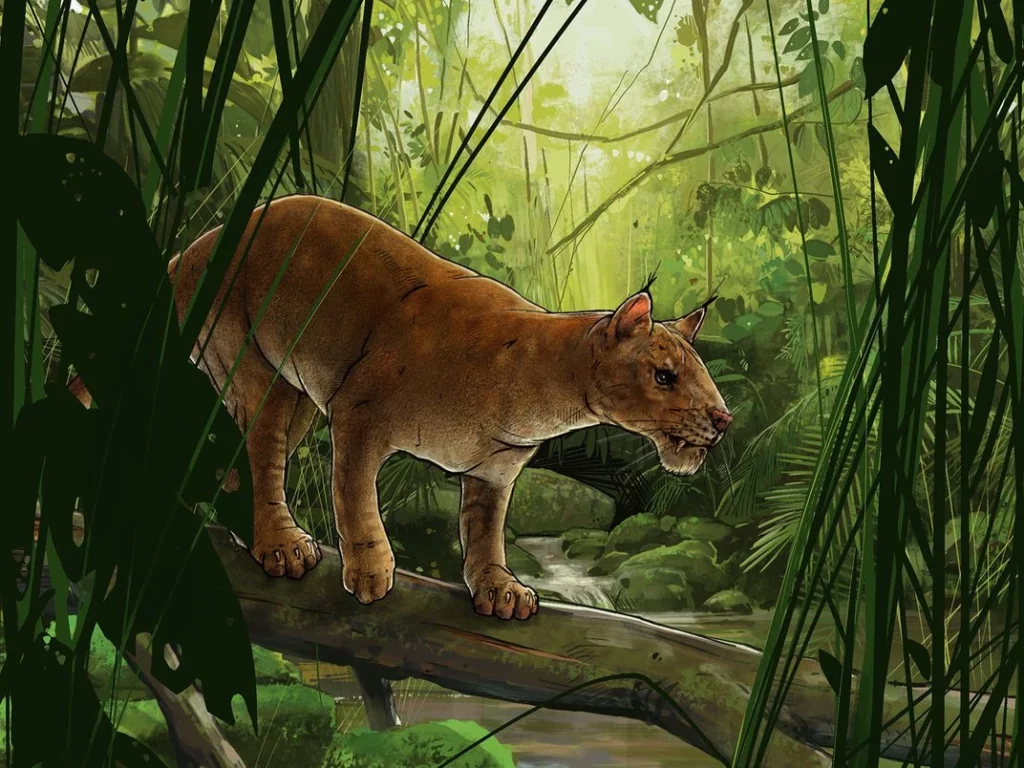Some 40 million years ago, in the luxurious tropical forests of California, a fierce predator with saber-like teeth crept in the shadows, patiently waiting to pounce on unsuspecting prey. This ancient mammal was the size of a bobcat and exclusively consumed a meat-based diet. That sounds a lot like a tiger or lion, but according to a new study, this saber-toothed mammal had nothing to do with the feline lineage. However, it seems to have represented a pioneering experiment of evolution that may have set the stage for the big cats that appeared much later.

The newly described predator belongs to a mysterious group of mammals called Machaeroidines, whose name means “dagger-tooth” in Greek. This group contains many of the extinct predators commonly known as “saber-toothed cats”, which includes the famed Smilodon. Named Diegoaelurus vanvalkenburghae, the fierce ancient predator, dated to 42 million years ago, is now believed to be the oldest example of a saber-toothed mammal in the world found thus far.
The discovery was made by a team of researchers led by San Diego Natural History Museum paleontologist Ashley Poust. The animal’s fossils were first found in the Santiago Formation, a group of rocks in southern California, during construction work. However, the fossils — consisting of a lower jaw and well-preserved teeth — were kept in storage and remained understudied until Poust came across them in the museum’s fossil library.
The strange jaw immediately piqued Poust’s interest and upon closer inspection, the fossils turned out to represent one of the first cat-like approaches to an all-meat diet.
“Big changes in the history of life are exciting because they give us insight into how evolution works, insight into how we got here. Evolving to eat an all-meat diet is a big change, and requires some very specialized equipment, sharp claws, blade-like teeth. Our new fossil is a saber-toothed predator, which is even more specialized than other carnivores,” Poust told ZME Science.
“Saber-teeth are a cool adaptation because they’re very distinctive and evolved several times independently, and yet we only know about them because of fossils. Diegoaelurus is an exciting discovery because it is one of the very few fossils of the first mammal group to evolve saber-teeth, tens of millions of years before the more familiar saber-tooth cats.”
Although the fossils were clearly exciting, they were incomplete, and making sense of the species they belong to and how it fits in the tree of life proved challenging. The big enigma was the missing tooth from the lower jaw, which showed no signs of damage or illness. But thanks to an unorthodox CT scan at the local Naval Hospital in San Diego, Poust was able to figure out that the gap in the jaw was totally filled with healthy bone.
“It is pretty unusual for a hospital to have a 42 million-year-old patient! After scanning we learned that the space is totally filled in with healthy bone, so whatever happened, Diegoaelurus lost the tooth earlier in life with enough time to heal,” the paleontologist said.

Diegoaelurus likely hunted primates and marsupials that were hanging from the canopies above. Perhaps, it also hunted early tapirs and sheep-like herbivores that grazed under the trees.
Despite their fascinating appearance, machaeroidines are very poorly understood due to the sparse fossil record, with only a handful of specimens discovered thus far, mostly in Wyoming and Asia. Diegoaelurus is the earliest Machairodontinae that we know of, but it probably shared the scene with other formidable predators since it appeared relatively close in time to the next cat-like animals in North America, the nimravids or sabre-tooth false-cats.
However, Poust stresses that there is no close relationship between Diegoaelurus and saber-tooth cats, or any cats for that matter. This is a completely new predator that precedes the emergence of modern cats by millions of years. It’s just that super long, knife-like teeth are very effective adaptations that predators like Smilodon have employed independently many times throughout evolutionary history — a fine example of what scientists call convergent evolution.
“Which makes it strange that we don’t have any saber-tooth mammals today. In the millions of years between the two groups there was even another group, Nimravids, that also adapted to be saber-toothed! Learning more about that group that took over after Diegoaelurus and its kin went extinct will be essential for understanding more about the evolution of meat-eating,” Poust said.
The findings appeared in the open-access journal PeerJ.


